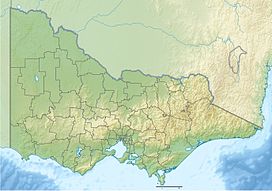Mt Eccles
| Budj Bim | |
|---|---|
| Mount Eccles | |
| Highest point | |
| Elevation | 178 m (584 ft) |
| Coordinates | 38°04′S 141°55′E / 38.067°S 141.917°ECoordinates: 38°04′S 141°55′E / 38.067°S 141.917°E |
| Geography | |
| Location | Victoria, Australia |
| Climbing | |
| Easiest route | Lava Canal track |
Budj Bim or Mount Eccles is an extinct volcano near Macarthur in southwestern Victoria, Australia. Budj Bim is also the Gunditjmara name, meaning High Head. The roughly conical shaped peak rises 178 metres (584 ft). The peak is a scoria hill that was thrown up beside a group of three overlapping volcanic craters that now contain Lake Surprise. A line of smaller craters and scoria cones runs to the southeast. Lava flows extend to form a shield volcano and are fed by several lava channels, or "lava canals" as they are known locally.
Initial estimates of the age of the eruption were all "minimum ages" from swamps that formed some time after the eruption and ranged from 6000 to 27,000 years, but the latest evidence suggests that the eruption was at least 30,000 years ago (using dated sediments in the floor of the Lake Surprise crater) and could have been as old as 40,000 for the Tyrendarra lava flow.
The eruptions produced the Tyrendarra lava flow which flowed in a generally southerly direction into the ocean at Tyrendarra, 50 kilometres (31 mi). The flow disrupted the earlier drainage system; to the east the Fitzroy River now flows cleanly between the rocks of the lava flow and the Mount Clay escarpment; to the west its tributary Darlot Creek flows through a more complex landscape of swamps, wetlands and adjacent low-lying land prone to flooding.
The eruptions altered the drainage in the area producing wetlands of the Budj Bim National Heritage Landscape. The name Budj Bim has been given to two areas on the Australian National Heritage List, proclaimed in 2004, the Budj Bim National Heritage Landscape - Tyrendarra Area and the Budj Bim National Heritage Landscape - Mount Eccles Lake Condah Area.
The Budj Bim areas have been included on the Heritage List because of their importance in the history of the Gunditjmara.
From some thousands of years before European occupation, the Gunditjmara developed a system of aquaculture which channelled the water of the Darlot Creek into adjacent lowlying areas trapping eels and fish in a series of weirs. This provided a year-round supply of eels which were harvested with woven traps and often smoked in hollows of the Manna Gum (Eucalyptus viminalis), and permitted a forager society to develop into a settled society constructing permanent stone dwellings.
...
Wikipedia

